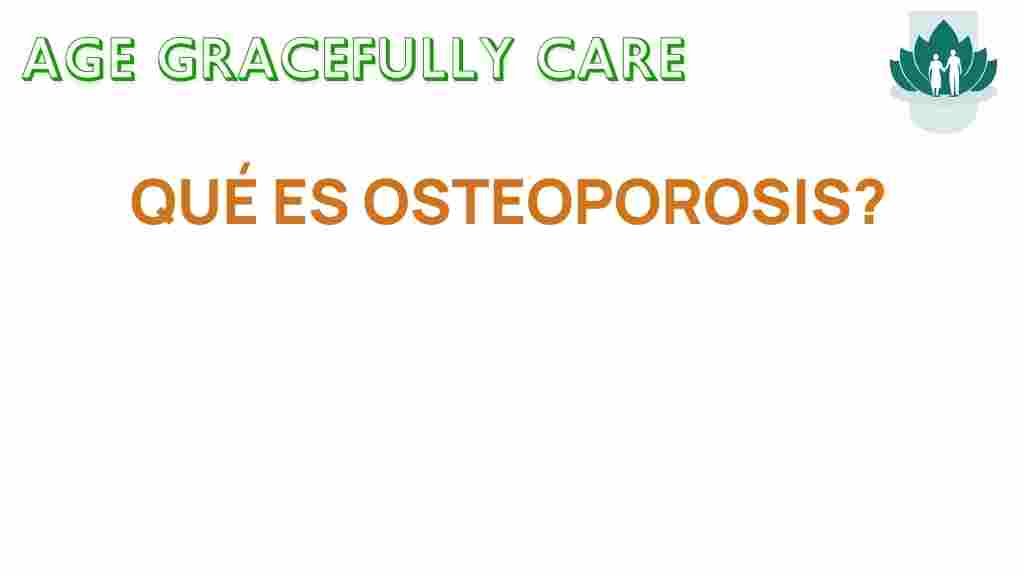Unlocking the Secrets of Osteoporosis: What You Need to Know
Osteoporosis is a silent disease that affects millions of people worldwide, especially as they age. Understanding osteoporosis and how to maintain bone health is crucial for prevention and effective treatment. This article will explore the risk factors, treatment options, lifestyle changes, and nutritional needs associated with osteoporosis, empowering you with the knowledge to protect your bones.
Understanding Osteoporosis
Osteoporosis is a condition characterized by weakened bones that are more susceptible to fractures. This deterioration of bone density can occur without any noticeable symptoms until a fracture occurs. The primary factors contributing to the development of osteoporosis include:
- Age: The risk increases as you get older.
- Gender: Women are at a higher risk, particularly post-menopause.
- Family history: A family history of osteoporosis can increase your risk.
- Body frame size: Smaller body frames tend to have a higher risk.
Risk Factors for Osteoporosis
Identifying risk factors is crucial for prevention. Here are some common risk factors associated with osteoporosis:
- Aging: Bone density decreases with age, making older adults more vulnerable.
- Hormonal changes: Women experience a decrease in estrogen after menopause, leading to bone loss.
- Lifestyle choices: Smoking and excessive alcohol consumption can weaken bones.
- Nutrition: A diet low in calcium and vitamin D can contribute to bone loss.
- Medical conditions: Certain diseases like rheumatoid arthritis, celiac disease, and hyperthyroidism can affect bone health.
- Medications: Long-term use of corticosteroids and other medications can impact bone density.
Preventing Osteoporosis: Lifestyle Changes
Prevention is key when it comes to osteoporosis. Implementing healthy lifestyle choices can significantly reduce your risk. Here are some effective strategies:
1. Nutrition for Bone Health
Proper nutrition plays a vital role in maintaining bone health. Focus on:
- Calcium: Aim for 1,000-1,200 mg of calcium per day through dairy products, leafy greens, and fortified foods.
- Vitamin D: Essential for calcium absorption; get it from sunlight, fatty fish, and fortified foods.
- Protein: Supports bone structure; include lean meats, beans, and nuts in your diet.
- Fruits and vegetables: Rich in antioxidants and important nutrients for bone health.
2. Physical Activity
Regular exercise strengthens bones and improves balance, reducing the risk of falls. Incorporate:
- Weight-bearing exercises: Activities like walking, jogging, and dancing.
- Strength training: Lifting weights or resistance exercises to build muscle.
- Balance exercises: Tai chi, yoga, and simple balance exercises to prevent falls.
3. Avoiding Risky Habits
Certain habits can increase your risk of osteoporosis:
- Smoking: Quitting smoking is crucial for bone health.
- Excessive alcohol: Limit alcohol consumption to moderate levels.
Treatment Options for Osteoporosis
For those diagnosed with osteoporosis, various treatment options are available to manage the condition and improve bone health:
1. Medications
Several medications can help strengthen bones and prevent fractures:
- Bisphosphonates: These drugs slow down bone loss.
- Hormone-related therapy: Estrogen therapy can be effective for postmenopausal women.
- Monoclonal antibodies: Denosumab is an example that can help reduce bone loss.
- Parathyroid hormone: Teriparatide may be prescribed to stimulate bone growth.
2. Supplements
If dietary intake is inadequate, consider the following supplements:
- Calcium supplements: If you struggle to meet calcium needs through food.
- Vitamin D supplements: To ensure sufficient vitamin D levels for calcium absorption.
3. Regular Check-ups
Regular bone density tests can help monitor your bone health, especially if you have risk factors for osteoporosis. Consult with your healthcare provider about when to start testing.
Awareness and Education
Raising awareness about osteoporosis is essential for prevention and treatment. Here are some ways to increase awareness:
- Education: Attend workshops and seminars on bone health.
- Community programs: Participate in local health initiatives focused on osteoporosis.
- Support groups: Join groups to connect with others facing similar challenges.
For more resources, you can visit the National Osteoporosis Foundation for comprehensive information on osteoporosis and bone health.
Conclusion
Osteoporosis is a significant health concern, particularly as we age. However, with the right knowledge about risk factors, prevention strategies, treatment options, and lifestyle changes, you can take proactive steps to safeguard your bone health. By focusing on proper nutrition, regular exercise, and staying informed, you can significantly reduce your risk of osteoporosis and maintain a healthy, active lifestyle. Remember, awareness is the first step toward prevention.
For more information on how to maintain your health as you age, check out our comprehensive guide on healthy aging.
This article is in the category Health and created by AgeGracefullyCare Team
